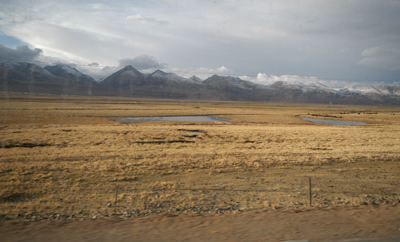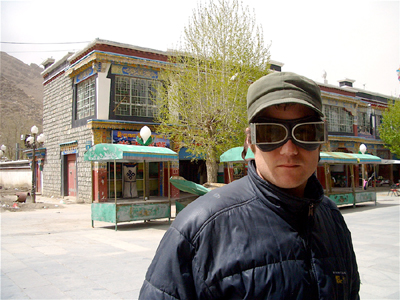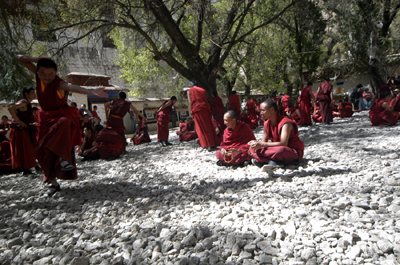|

Along the road north to Golmud
From the Chengdu Gonzo Field Office
By Freeman Anthony
This is a wiped out agent talking. I'm sitting in the foyer of the
dorm room here at the Rongcheng Hostel in the hazy city of Chengdu.
This is the heartland of China: equal parts haze, terraced paddies and
concrete. The reason for my damaged condition? The 60-plus hour bus
ride that brought me here.
The Tibet squad parted company in Lhasa on the morning of the 2nd as
the team, save myself, flew back to Kathmandu. Simon had booked a ticket
just the day before, as he'd changed his mind on the overland trip back
to Nepal. No need to do that again.

Trying on dated mountaineering glasses in Shigatse
Lhatse left me wondering if I was up for the trip, if I had underestimated
the effects of 5,500 meters. We were promised a short drive to the first
of many Tibetan Buddhist monasteries. With chin high and stomach on
toast and tea, I made it awake to Shigaste, the seat of the Panchen
Lama, a place of history and suspicion. Once home to around 5,000 monks,
this monastery today houses a couple hundred who tend the yak butter
wax and bowls of sunflower seed offerings. The Panchen Lama today represents
a predictably Chinese twist of one of the main arms of Tibetan Buddhism.
Passing through the monastery gates, I glimpse the real deal: a maze-like
network of mud brick hallways, temples, sleeping quarters, and holy
stupas built in the mid-1400s. The rough stone pavers and plastered
walls are gray and white, with black wood and mud roofs peering over
top. These drab colors contrast the sewn "ruffles" along the
top of each window frame and the painted columns and "tankas"
in the interior courtyards. Scattered amongst this geometric system
of buildings sit circular stupas with gold painted spires and little
nooks smudged with incense. A few ragged pilgrims circumnavigate the
stupas and temples at an easy pace, matching their trips around with
the number of years they've circled the sun.
Each monastery contains an assembly hall, a couple large temples, and
countless smaller altars. The temples typically feature Buddha in some
incarnation, and the smaller altars contain Buddha or other deities,
such as famous past Kings, Lamas and the demonic looking "Protectors."
We step into one of Shigatse's main temples and gaze upon the largest
inside Buddha in Tibet. This guy looms 13 meters tall (about 43 feet),
and you cannot see all of him at one time. All the statues, regardless
of size, sport colorful, quilted robes, similar to the elaborately stitched
wall hangings and doorway covers. Several large steel urns of yak butter
sit on a large flat wood table in front, each with a dozen or so wicks
tended by the on duty monks. These monks ritually snip tops off wicks
and tap the waste into large tin pots, making a tinny sound that echoes
in muffled silence.
The only other noise: the shuffling of feet in a clockwise direction
around the Buddha, by tourists and pilgrims alike. Only a few other
parties visit the monastery today, one from the Netherlands and a few
from Japan or China. A guide assigned to each group gives his own interpretation
of the significance of each statue. Pilgrims have tucked countless 1
and 5 Jaio (0.1 - 0.5 yuan) notes around the statues like Easter eggs,
which are presumably collected once in a while.

Monks debating at the Sera Monastery
|